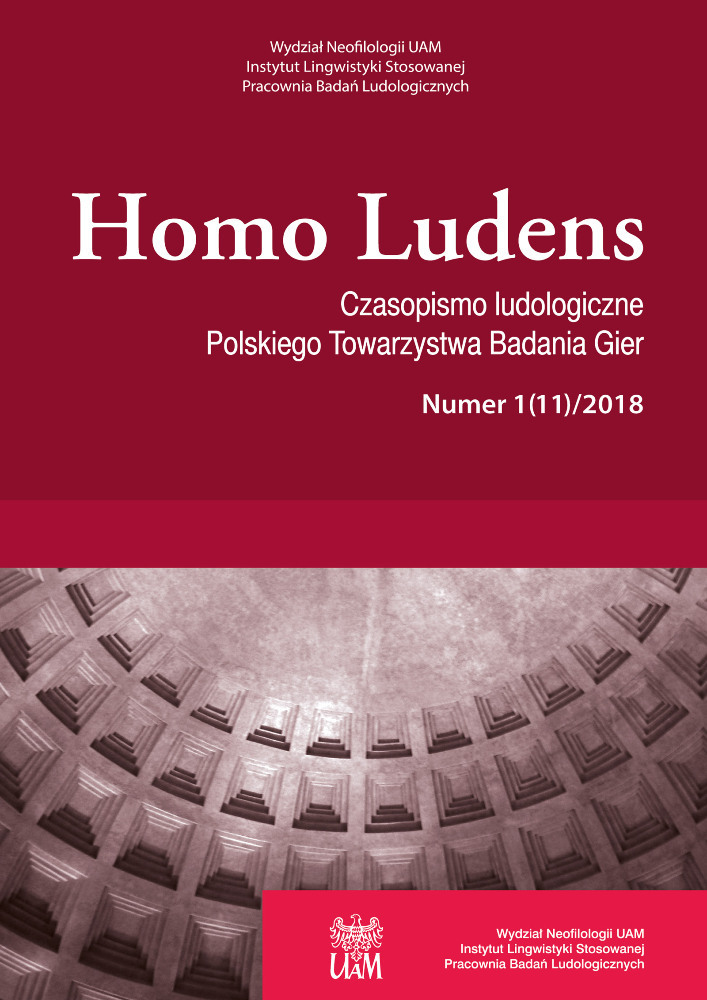Abstract
The aim of the article was to determine the emotional and motivational attitudes of university students toward selected elements of gamification. Levels of motivating and liking for the use of the following tools were measured: instant messengers, points, badges, leader boards, quests, challenges, progress bar, levels, individual and group competition, cooperation, exchange systems and virtual goods. Additionally, opinions
about small monetary rewards were examined. The results showed that students were generally interested in the use of gamification techniques. In particular, elements leading to receiving better grades and improving learning organization were evaluated more positively. Lower scores were given to mechanisms potentially threatening the students’ self-esteem.
References
Berridge, K. C., Robinson, T. E. (1998). What is the role of dopamine in reward: Hedonic impact, reward learning, or incentive salience? Brain Research Reviews, 28(3), 309–369.
Borys, M., Laskowski, M. (2013). Implementing game elements into didactic process: A case study. Online: <http://www.toknowpress.net/ISB-N/978?961?6914?02?4/papers/ML13?326.pdf.
Conway, S. (2014). Zombification?: Gamification, motivation, and the user. Journal of Gaming & Virtual Worlds, 6(2), 129–141.
Deci, E. (1971). Effects of externally mediated rewards on intrinsic motivation. Journal of Personality and Social Psychology, 18(1), 105–115. Online: http://www.quilageo.com/wp-content/uploads/2013/07/fn103.Deci_.pdf.
Deterding, S. (2010). Pawned. Gamification and Its Discontents. Online: https://www.slideshare.net/dings/pawned-gamification-and-its-discontents.
Deterding, S. (2011). Situated motivational affordances of game elements: A conceptual model. Online: http://gamification-research.org/wp-content/uploads/2011/04/09-Deterding.pdf.
Deterding, S. (2014). Eudaimonic design, or: Six invitations to rethink gamification. W: M. Fuchs, S. Fizek, P. Ruffino, N. Schrape (red.), Rethinking Gamification (s. 305–331). Lüneburg: Meson Press. Online: http://meson.press/wp-content/uploads/2015/03/9783957960016-rethinking-gamification.pdf.
Deterding, S., Khaled, R., Nacke, L., and Dixon, D. (2011). Gamification: Toward a definition. Online: http://gamification-research.org/wp-content/uploads/2011/04/02-Deterding-Khaled-Nacke-Dixon.pdf.
Hamari, J., Koivisto, J., Sarsa, H. (2014). Does gamification work? – A literature review of empirical studies on gamification. Online: http://ieeexplore.ieee.org/stamp/stamp.jsp?tp=&arnumber=6758978.
Howard-Jones, P. A., Demetriou S. (2008). Uncertainty and engagement with learning games. Instructional Science, 37(6), 519–536.
Juul, J. (2 kwietnia 2011). Gamification backlash roundup. The Ludologist, Online: http://www.jesperjuul.net/ludologist/gamification-backlash-roundup.
Juul, J. (2016). Sztuka przegrywania (tłum. P. Schreiber, M. Tabaczyński). Kraków: Korporacja Ha!art.
Kopeć, J. (2015). Let’s put programs in our minds. The ideology of gamification. Case study of HabitRPG. W: J. Kopeć, K. Pacewicz (red.), Gamification. Critical approaches (s. 9–26). Warszawa: The Faculty of “Artes Liberales”, University of Warsaw.
Kopeć, J. Pacewicz, K. (red.), Gamification. Critical approaches. Warszawa: The Faculty of “Artes Liberales”, University of Warsaw.
Lepper, M. R., Greene, D., Nisbett, R. E. (1973). Undermining children’s intrinsic interest with extrinsic rewards: A test of the “overjustification” hypothesis. Journal of Personality and Social Psychology, 28(1), 129–137.
Lopez, S. (19 października 2011). Disneyland workers answer to “electronic whip”. Online: http://articles.latimes.com/2011/oct/19/local/la-me-1019-lopez-disney-20111018.
Mochocki, M. (23 września 2012). Gamifikacja szkolnictwa wyższego: obce wzorce, polskie perspektywy. Online: http://www.slideshare.net/BILUSZ/gamifikacja-szkolnictwa-wyszego-obce-wzorce-polskie-perspektywy-14413868.
Mollick, E. R., Rothbard, N. (2014). Mandatory fun: consent, gamification and the impact of games at work. Online: http://papers.ssrn.com/sol3/papers.cfm?abstract_id=2277103.
Oravec, J. A. (2015). Gamification and multigamification in the workplace: Expanding the ludic dimensions of work and challenging the work/play dichotomy. Cyberpsychology: Journal of Psychosocial Research on Cyberspace, 9(3). Online: http://cyberpsychology.eu/view.php?cisloclanku=2015101501&article=6.
Pettit, R. K., McCoy, L., Kinney, M., Schwartz, F. N. (2015). Student perceptions of gamified audience response system interactions in large group lectures and via lecture capture technology. Online: https://old.biomedcentral.com/content/pdf/s12909–015–0373–7.pdf.
Smoleń, M. (2015). Gamification as creation of a social system. W: J. Kopeć, K. Pacewicz (red.), Gamification. Critical approaches (s. 56–68). Warszawa: The Faculty of “Artes Liberales”, University of Warsaw.
Starzyński, S. (27 stycznia 2012). 3 „F” gryfikacji. Online: http://www.gryfikacja.pl/index.php/2012/01/3-f-gryfikacji.
Tkaczyk, P. (2012). Grywalizacja. Jak zastosować mechanizmy gier w działaniach marketingowych. Gliwice: Helion.
Tsai, C. (22 czerwca 2011). Al Gore: ‘Games Are the New Normal’. Online: http://www.huffingtonpost.com/charles-tsai/al-gore-games-social-good_b_881017.html.
Whitson, J. R. (2013). Gaming the quantified self. Surveillance & Society, 11(1/2), 163–176. Online: http://library.queensu.ca/ojs/index.php/surveillance-and-society/article/view/gaming/gaming.
Zichermann, G., Cunningham, C. (2011). Gamification by design: Implementing game mechanics in web and mobile apps. Sebastopol: O’Reilly Media, Inc.
Data dostępu do źródeł internetowych wykorzystanych w tekście: 11 lipca 2017 (jeśli nie wskazano inaczej).

